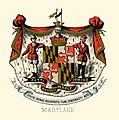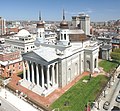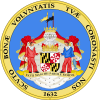Portal:Maryland
|
Maryland Portal
|
Baltimore Task Force
|
Frederick Task Force
|
Montgomery Task Force
|
WikiProject Maryland
|
|
Main page
|
Discussion
|
Introduction Maryland (US: /ˈmɛrɪlənd/ ⓘ MERR-il-ənd) is a state in the Mid-Atlantic region of the United States. The state borders Virginia to its south, West Virginia to its west, Pennsylvania to its north, Delaware to its east, the Atlantic Ocean, and the national capital of Washington, D.C. With a total area of 12,407 square miles (32,130 km2), Maryland is the ninth-smallest state by land area, and its population of 6,177,224 ranks it the 18th-most populous state and the fifth-most densely populated. Maryland's capital is Annapolis, and the most populous city is Baltimore. Occasional nicknames include Old Line State, the Free State, and the Chesapeake Bay State. It is named after Henrietta Maria, the French-born queen of England, Scotland, and Ireland during the 17th century. Maryland's coastline was first explored by Europeans in the 16th century. Prior to that, it was inhabited by several Native American tribes, mostly the Algonquian peoples and, to a lesser degree, Iroquoians and Siouans. As one of the original Thirteen Colonies, Maryland was founded by George Calvert, 1st Baron Baltimore, a Catholic convert who sought to provide a religious haven for Catholics persecuted in England. In 1632, Charles I of England granted Lord Baltimore a colonial charter, naming the colony after his wife, Henrietta Maria. Unlike the Pilgrims and Puritans, Lord Baltimore envisioned a colony where people of different religious sects would coexist under the principle of toleration. In 1649, the Maryland General Assembly passed an Act Concerning Religion, which enshrined this principle by penalizing anyone who "reproached" a fellow Marylander based on religious affiliation. Nevertheless, religious strife was common in the early years, and Catholics remained a minority, albeit in greater numbers than in any other English colony. Maryland's early settlements and population centers clustered around rivers and other waterways that empty into the Chesapeake Bay. Its economy was heavily plantation-based and centered mostly on the cultivation of tobacco. Demand for cheap labor from Maryland colonists led to the importation of numerous indentured servants and enslaved Africans. In 1760, Maryland's current boundaries took form following the settlement of a long-running border dispute with Pennsylvania. Maryland was an active participant in the events leading up to the American Revolution, and by 1776, its delegates signed the Declaration of Independence. Many of its citizens subsequently played key political and military roles in the war. Although then a slave state, Maryland remained in the Union during the American Civil War, its strategic location giving it a significant role in the conflict. After the Civil War, Maryland took part in the Industrial Revolution, driven by its seaports, railroad networks, and mass immigration from Europe. Since the 1940s, the state's population has grown rapidly, to approximately six million residents, and it is among the most densely populated U.S. states. , Maryland had the highest median household income of any state, owing in large part to its proximity to Washington, D.C., and a highly diversified economy spanning manufacturing, retail services, public administration, real estate, higher education, information technology, defense contracting, health care, and biotechnology. Maryland is one of the most multicultural states in the country; it is one of the six states where non-Whites compose a majority of the population, with the fifth-highest percentage of African Americans, and high numbers of residents born in Africa, Asia, Central America, and the Caribbean. The state's central role in U.S. history is reflected by its hosting of some of the highest numbers of historic landmarks per capita. (Full article...) This is a Featured article, which represents some of the best content on English Wikipedia..
The Royal Blue was the Baltimore and Ohio Railroad (B&O)'s flagship passenger train between New York City and Washington, D.C., in the United States, beginning in 1890. The Baltimore-based B&O also used the name between 1890 and 1917 for its improved passenger service between New York and Washington, collectively dubbed the Royal Blue Line. Using variants such as the Royal Limited and Royal Special for individual Royal Blue trains, the B&O operated the service in partnership with the Reading Railroad and the Central Railroad of New Jersey. Principal intermediate cities served were Philadelphia, Wilmington, and Baltimore. Later, as Europe reeled from the carnage of World War I and connotations of European royalty fell into disfavor, the B&O discreetly omitted the sobriquet Royal Blue Line from its New York passenger service and the Royal Blue disappeared from B&O timetables. Beginning in 1917, former Royal Blue Line trains were renamed: the Royal Limited (inaugurated on May 15, 1898), for example, became the National Limited, continuing west from Washington to St. Louis via Cincinnati. During the Depression, the B&O hearkened back to the halcyon pre-World War I era when it launched a re-christened Royal Blue train between New York and Washington in 1935. The B&O finally discontinued all passenger service north of Baltimore on April 26, 1958, including the Royal Blue. Railroad historian Herbert Harwood said, in his seminal history of the service, "First conceived in late Victorian times to promote a new railroad line ... it was indeed one of the most memorable images in the transportation business, an inspired blend of majesty and mystique ... Royal Blue Line ... Royal Blue Trains ... the Royal Blue all meant different things at different times. But essentially they all symbolized one thing: the B&O's regal route." Between the 1890s and World War I, the B&O's six daily Royal Blue trains providing service between New York and Washington were noted for their luxury, elegant appearance, and speed. The car interiors were paneled in mahogany, had fully enclosed vestibules (instead of open platforms, still widely in use at the time on U.S. railroads), then-modern heating and lighting, and leaded glass windows. The car exteriors were painted a deep "Royal Saxony blue" color with gold leaf trim, a color personally chosen by the B&O's tenth president, Charles F. Mayer. (Full article...)General imagesIn the news
On this day...This is a Good article, an article that meets a core set of high editorial standards.
 The Maryland Terrapins football team represents the University of Maryland, College Park in the sport of American football. The Terrapins compete in the NCAA Division I Football Bowl Subdivision (FBS) and the Big Ten Conference. The Terrapins joined the Big Ten Conference on July 1, 2014, following 62 years in the Atlantic Coast Conference as a founding member. Mike Locksley is the head coach of the Terrapins. Since 1950, the Terrapins have played their home games at SECU Stadium in College Park, Maryland, with occasional home games from time to time in Baltimore, making them one of two FBS football teams in the Baltimore–Washington metropolitan area (Navy Midshipmen) and the closest Football Bowl Subdivision team to Washington, D.C. The team's official colors of red, white, black, and gold have been in use in some combination since the 1920s and are taken from Maryland's state flag, and the Terrapins nickname — often abbreviated as "Terps" — was adopted in 1933 after the diamondback terrapin, a turtle species native to the state. Maryland shares storied rivalries with Virginia and West Virginia. (Full article...)Selected article -
Jarvis U.S. General Hospital was a military hospital founded in Baltimore, Maryland, in 1861, at the beginning of the American Civil War, for the care of wounded Federal soldiers. The hospital was built on the grounds of Maryland Square, the former residence of the Steuart family, which had been confiscated by the Federal government at the outbreak of war. The hospital closed at the end of the war. (Full article...)
Did you know?

SubcategoriesSelect [+] to view subcategories
TopicsRelated portalsAssociated WikimediaThe following Wikimedia Foundation sister projects provide more on this subject:
Discover Wikipedia using portals |
























































